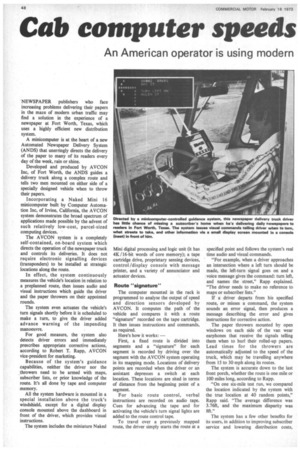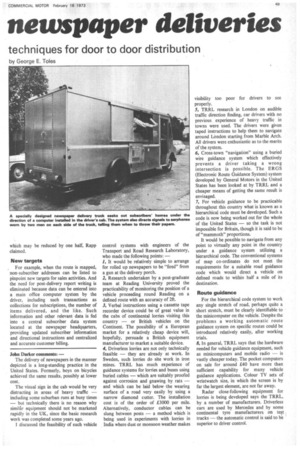Cab computer speeds newspaper deliveries
Page 50

Page 51

If you've noticed an error in this article please click here to report it so we can fix it.
An American operator is using modern techniques for door to door distribution
by George E. Toles 'NEWSPAPER publishers who face increasing problems delivering their papers in the maze of modern urban traffic may find a solution in the experience of a newspaper at Fort Worth, Texas, which uses a highly efficient new distribution system.
A minicomputer is at the heart of a new Automated Newspaper Delivery System (ANDS) that unerringly directs the delivery of the paper to many of its readers every day of the week, rain or shine.
Developed and produced by AVCON Inc, of Fort Worth, the ANDS guides a delivery truck along a complex route and tells two men mounted on either side of a specially designed vehicle when to throw their papers.
Incorporating a Naked Mini 16 minicomputer built by Computer Automation Inc, of Irvine, California, the AVCON system demonstrates the broad spectrum of applications made possible by the advent of such relatively low-cost, parcel-sized computing devices.
The AVCON system is a completely self-contained, on-board system which directs the operation of the newspaper truck and controls its deliveries. It does not require electronic signalling devices (transponders) to be installed at strategic locations along the route.
In effect, the system continuously measures the vehicle's location in relation to a preplanned route, then issues audio and visual instructions which guide the driver and the paper throwers on their appointed rounds.
The system even actuates the vehicle's turn signals shortly before it is scheduled to make a turn, to give the driver added advance warning of the impending manoeuvre.
For good measure, the system also detects driver errors and immediately prescribes appropriate corrective actions, according to Robert T. Rapp, AVCON vice-president for marketing.
Because of the system's guidance capabilities, neither the driver nor the .throwers need to be armed with maps, subscriber lists, or prior knowledge of the route. It's all done by tape and computer memory.
All the system hardware is mounted in a special installation above the truck's windshield, except for a digital display console mounted above the dashboard in front of the driver, which provides visual instructions.
The system includes the miniature Naked Mini digital processing and logic unit (it has 4K/16-bit words of core memory); a tape cartridge drive, proprietary sensing devices, control/display console with message printer, and a variety of annunciator and actuator devices.
Route "signature"
The computer mounted in the rack is programmed to analyse the output of speed and direction sensors developed by AVCON. It computes the path of the vehicle and compares it with a route "signature" recorded on the tape cartridge. It then issues instructions and commands, as required.
Here's how it works: — First, a fixed route is divided into segments and a "signature" for each segment is recorded by driving over the segment with the AVCON system operating in its mapping mode. Locations of delivery points are recorded when the driver or an assistant depresses a switch at each location. These locations are sited in terms of distance from the beginning point of a segment.
For basic route control, verbal instructions are recorded on audio tape. Cues for advancing the tape and for activating the vehicle's turn signal lights are added to the route control tape.
To travel over a previously mapped route, the driver simply starts the route at a specified point and follows the system's real time audio and visual commands.
"For example, when a driver approaches an intersection where a left turn should be made, the left-turn signal goes on and a voice message gives the command: turn left, and names the street," Rapp explained. "The driver needs to make no reference to maps or subscriber lists.".
If a driver departs from his specified route, or misses a command, the system sounds an error signal, then produces a message describing the error and gives instructions for corrective action.
The paper throwers mounted by open windows on each side of the van wear earphones that receive the signals telling them when to hurl their rolled-up papers. Lead times for the throwers are automatically adjusted to the speed of the truck, which may be travelling anywhere from 15 to 30 mph along its routes.
The system is accurate down to the last front porch, whether the route is one mile or 100 miles long, according to Rapp.
"On one six-mile test run, we compared the location indicated by the system with the true location at 40 random points," Rapp said. "The average difference was 3.7611, and the maximum disparity was 8ft."
The system has a few other benefits for its users, in addition to improving subscriber service and lowering distribution costs, which may be reduced by one half, Rapp claimed.
New targets . For example, when the route is mapped, non-subscriber addresses can be listed to pinpoint new targets for sales activities. And the need for post-delivery report writing is eliminated because data can be entered into a main office computer system by the driver, including such transactions as collections for subscriptions, the number of items delivered, and the like. Such information and other relevant data is fed into a central subscriber data system located at the newspaper headquarters, providing updated subscriber information and directional instructions and centralized and accurate customer billing.
John Darker comments: —
The delivery of newspapers in the manner depicted is a long-standing practice in the United States. Formerly, boys on bicycles achieved the same results, possibly at lower cost.
The visual sign in the cab would be very distracting in areas of heavy traffic — including some suburban runs at busy times — but technically there is no reason why similar equipment should not be marketed rapidly in the UK, since the basic research work was completed some years ago.
I discussed the feasibility of such vehicle control systems with engineers of the Transport and Road Research Laboratory, who made the following points: — /, It would be relatively simple to arrange for rolled up newspapers to be "fired" from a gun at the delivery porch.
2, Research undertaken by a post-graduate team at Reading University proved the practicability of monitoring the position of a vehicle proceeding round Reading on a defined route with an accuracy of 2ft.
3, Verbal instructions using a cassette tape recorder device could be of great value in the cabs of continental lorries visiting this country — or British vehicles on the Continent. The possibility of a European market for a relatively cheap device will, hopefully, persuade a British equipment manufacturer to market a suitable device.
4, Driverless lorries are not only technically feasible — they are already at work. In Sweden, such lorries do site work in iron mines. TRRL has much experience of guidance systems for lorries and buses using buried cables — which are suitably proofed against corrosion and gnawing by rats — and which can be laid below the wearing surface of a road very easily by using a narrow diamond cutter. The installation cost is of the order of £3000 per mile. Alternatively, conductor cables can be slung between posts — a method which is being used in experiments with lorries in India where dust or monsoon weather makes visibility too poor for drivers to see properly.
5, TRRL research in London on audible traffic direction finding, car drivers with no previous experience of heavy traffic in towns were used. The drivers were given taped instructions to help them to navigate around London starting from Marble Arch. All drivers were enthusiastic as to the merits of the system.
6, Cross-town "navigation" using a buried wire guidance system which effectively prevents a driver taking a wrong intersection is possible. The ERGS (Electronic Route Guidance System) system developed. by General Motors in the United States has been looked at by TRRL and a cheaper means of getting the same result is envisaged.
7, For vehicle guidance to be practicable throughout this country what is known as a hierarchical code must be developed. Such a code is now being worked out for the whole of the United States — so the task is not impossible for Britain, though it is said to be of "mammoth" proportions.
It would be possible to navigate from any point to virtually any point in the country under a guidance system utilizing a hierarchical code. The conventional systems of map co-ordinates do not meet the requirements for a suitable road guidance code which would direct a vehicle on defined roads to within half a mile of its destination.
Route guidance For the hierarchical code system to work any single stretch of road, perhaps quite a short stretch, must be clearly identifiable to the minicomputer on the vehicle. Despite the problems a working automatic route guidance system on specific routes could be introduced relatively easily, after working trials.
8, In general, TRRL says that the hardware needed for vehicle guidance equipment, such as minicomputers and mobile radio is vastly cheaper today. The pocket computers on sale for around £40 have more than sufficient capability for many vehicle guidance applications. Colour TV sets of wristwatch size, in which the screen is by far the largest element, are not far away: Radar close-following equipment for lorries is being developed says the TRRL, by a number of manufacturers. Driverless cars are used by Mercedes and by some continental tyre manufacturers on test tracks the automatic control is said to be superior to driver control.












































































































